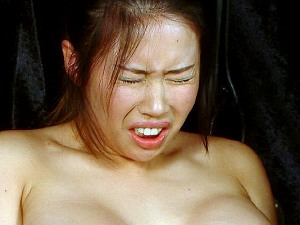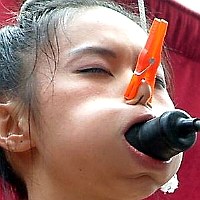
Japanese Rope Bondage Shibari |
Asian BDSM Menu |
|||||
| Japanese BDSM and Asian Bondage |
|
|||||
|
||||||
Bondage as a sexual activity first came to notice in Japan in the late Edo period. Generally recognized as "father of Kinbaku" is Seiu Ito, who started studying and researching Hojōjutsu is credited with the inception of Kinbaku, though it is noted that he drew inspiration from other art forms of the time including Kabuki theatre and Ukiyoe woodblock prints. Kinbaku became widely popular in Japan in the 1950s through magazines such as Kitan Club and Yomikiri Romance, which published the first naked bondage photographs. In the 1960s, people such as Eikichi Osada began to appear performing live SM shows often including a large amount of rope bondage, today these performers are often referred to as Nawashi (rope master) or Bakushi (from kinbakushi, meaning bondage master). In recent years, Kinbaku has become popular in the Western BDSM scene in its own right and has also profoundly influenced bondage, combining to produce many 'fusion' styles. |
||||||
|
||||||
Kinbaku is based on fairly specific rope patterns, many of them derived from Hojojutsu ties. Of particular importance are the Ushiro Takatekote (a type of arm box tie), which forms the basis of many Kinbaku ties, and the Ebi, or "Shrimp", which was originally designed as a torture tie and codified as part of the Edo period torture techniques. Today the tie is used as part of SM play and can be considered a form of Semenawa, torture rope. Generally speaking, Kinbaku is practiced with ropes of 6–8 meters (23 ft) in length. Due to the generally different physique of Western subjects, 8 meter (26 ft) ropes are commonly used in the West. The rope material is usually hemp or jute) though many other materials are in use including cotton and various synthetics. Various techniques are used to make the natural fiber ropes softer |
||||||
|
||||||
The aesthetics of the bound person's position is important: in particular, Japanese bondage is distinguished by its use of specific katas (forms) and aesthetic rules. Sometimes, asymmetric and often intentionally uncomfortable positions are employed. In particular, Japanese bondage is very much about the way the rope is applied and the pleasure is more in the journey than the destination. In this way the rope becomes an extension of the nawashi's hands and is used to communicate. For some excellent examples of japanese bondage visit Shibari Pics featuring oriental rope works and skills asian masters performing bondage arts. Traditional Japanese bondage techniques use natural vegetable fiber rope (hemp, jute, or linen) exclusively, though contemporary Japanese Masters have been working with a range of rope materials. The natural fibers easily lock to each other which means the bondage can be held together by the friction of twists and turns or very simple knots. Traditionally, multiple 6-8 meter lengths are used |
||||||
|
||||||
There is much discussion about the distinction between shibari and kinbaku, and whether one term is more appropriate than another. One modern distinction which is gaining popularity is that shibari refers to purely artistic, aesthetic rope, whilst kinbaku refers to the artistic, connective, sensual, sexual practice as a whole. A traditional view is that the term 'shibari' is a wrong Western Japonism. The word denotes tying in Japanese, but in a generic way, and traditionally not in the context of bondage. The names for many particular ties include 'shibari', but it is not traditional to call the entire activity that way. (In the same way as there are 'Diamond Knots' and 'Portuguese Bowline Knots', but 'knotting' does not mean bondage). Instead, Kinbaku is the term for artistic or erotic tying within traditional Japanese rope bondage circles. However, this is a somewhat hidebound definition and the word shibari is now increasingly being re-imported from the West to Japan, as the tying communities are very much interconnected. Most Japanese kinbakushi do not object to the term shibari, as it's common vernacular in the global community. |
||||||
Enter The Pain Files for more Extreme Japanese BDSM
 Gagged Asian Drooling Slavegirl |
 Asian Needle Bondage |
 Yakuras Suspension Bondage |















